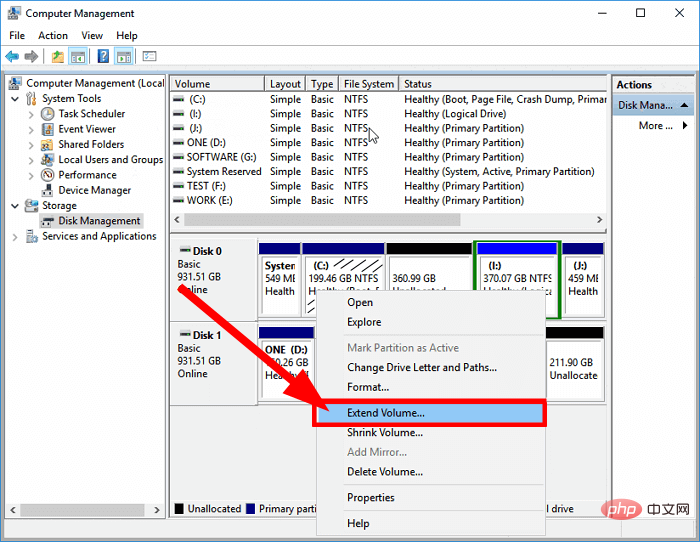In centos, tty is the abbreviation of "Teletype" and is the collective name for terminal equipment; Teletype is the earliest terminal equipment produced by Teletype Company. It is a character-type device and has many types. , the device name is placed in the special file directory "/dev/".

The operating environment of this article: centos 6.4 system, Dell G3 computer.
What does tty mean in centos
The terminal is a character-type device, which comes in many types. tty is usually used to refer to various types of terminal devices.
tty is the abbreviation of Teletype. Teletype was one of the earliest terminal devices, much like a teletypewriter (or ), and was produced by the Teletype Company. The device name is placed in the special file directory /dev/. The terminal special device files generally include the following types:
1. Serial port terminal (/dev/ttySn)
Serial Port Terminal is a terminal device connected using a computer serial port. The computer treats each serial port as a character device. There was a time when these serial port devices were often called terminal devices because their primary use at that time was for connecting to terminals. The device names corresponding to these serial ports are /dev/tts/0 (or /dev/ttyS0), /dev/tts/1 (or /dev /ttyS1), etc., and the device numbers are (4,0), ( 4,1), etc., respectively corresponding to COM1, COM2, etc. under the DOS system. To send data to a port, you can redirect standard output to these special file names on the command line. For example, typing at the command line prompt: echo test > /dev/ttyS1 will send the word "test" to the device connected to the ttyS1 (COM2) port.
2. Pseudo terminal (/dev/pty/)
Pseudo Terminal (Pseudo Terminal) is a pair of logical terminal devices, such as /dev/ptyp3 and / dev/ttyp3 (or /dev/pty/m3 and /dev/pty/s3 respectively in the device file system). They are not directly related to actual physical devices. If a program sees ttyp3 as a serial port device, its read/write operations on that port will be reflected on the other end of the logical terminal device pair (ttyp3). ttyp3 is a logical device used by another program for read and write operations. In this way, two programs can communicate with each other through this logical device, and one of the programs using ttyp3 thinks it is communicating with a serial port. This is much like a pipe operation between pairs of logical devices.
For ttyp3 (s3), any program designed to use a serial port device can use this logical device. But for programs that use ptyp3, they need to be specially designed to use ptyp3 (m3) logical devices.
For example, if someone uses the telnet program to connect to your computer on the Internet, the telnet program may start connecting to the device ptyp2 (m2) (a pseudo terminal port). At this time, a getty program should be running on the corresponding ttyp2 (s2) port. When telnet obtains a character from the remote end, the character will be passed to the getty program through m2 and s2, and the getty program will return the "login:" string information to the network through s2, m2 and the telnet program. In this way, the login program and the telnet program communicate through the "pseudo terminal". By using appropriate software, it is possible to connect two or even more pseudo-terminal devices to the same physical serial port.
Before using the device file system (device filesystem), in order to obtain a large number of pseudo-terminal device special files, HP-UX AIX and others used a more complex file naming method.
3. Control terminal (/dev/tty)
If the current process has a controlling terminal (Controlling Terminal), then /dev/tty is the current process Device special files that control the terminal. You can use the command "ps -ax" to see which control terminal the process is connected to. For the shell you log in to, /dev/tty is the terminal you use, and the device number is (5,0). Use the command "tty" to see which actual terminal device it corresponds to. /dev/tty is somewhat similar to a connection to the actual terminal device used.
4. Console terminal (/dev/ttyn, /dev/console)
In UNIX systems, the computer monitor is usually called the console terminal (Console ). It emulates a terminal of type Linux (TERM=Linux), and has some device special files associated with it: tty0, tty1, tty2, etc. When you log in at the console, tty1 is used. When using the Alt [F1-F6] key combination, we can switch to tty2, tty3, etc. tty1 – tty6 and so on are called virtual terminals, and tty0 is an alias of the currently used virtual terminal, and the information generated by the system will be sent to this terminal. Therefore, no matter which virtual terminal is currently being used, system information will be sent to the console terminal.
You can log in to different virtual terminals, so the system can have several different sessions at the same time. Only the system or super user root can write to /dev/tty0,
5. Other types
There are also many other types of terminal device special files for many different character devices. For example, /dev/ttyIn terminal device for ISDN equipment, etc.
Recommended tutorial: "centos tutorial"
The above is the detailed content of What does tty mean in centos. For more information, please follow other related articles on the PHP Chinese website!
 centos用什么命令可查版本号Mar 03, 2022 pm 06:10 PM
centos用什么命令可查版本号Mar 03, 2022 pm 06:10 PM查版本号的命令:1、“cat /etc/issue”或“cat /etc/redhat-release”,可输出centos版本号;2、“cat /proc/version”、“uname -a”或“uname -r”,可输出内核版本号。
 centos重启网卡的方法是什么Feb 22, 2023 pm 04:00 PM
centos重启网卡的方法是什么Feb 22, 2023 pm 04:00 PMcentos重启网卡的方法:1、对于centos6的网卡重启命令是“service network restart”;2、对于centos7的网卡重启命令是“systemctl restart network”。
 centos php怎么安装opcacheJan 19, 2023 am 09:50 AM
centos php怎么安装opcacheJan 19, 2023 am 09:50 AMcentos php安装opcache的方法:1、执行“yum list php73* | grep opcache”命令;2、通过“yum install php73-php-opcache.x86_64”安装opcache;3、使用“find / -name opcache.so”查找“opcache.so”的位置并将其移动到php的扩展目录即可。
 centos 怎么离线安装 mysqlFeb 15, 2023 am 09:56 AM
centos 怎么离线安装 mysqlFeb 15, 2023 am 09:56 AMcentos离线安装mysql的方法:1、将lib中的所有依赖上传到linux中,并用yum命令进行安装;2、解压MySQL并把文件复制到想要安装的目录;3、修改my.cnf配置文件;4、复制启动脚本到资源目录并修改启动脚本;5、将mysqld服务加入到系统服务里面;6、将mysql客户端配置到环境变量中,并使配置生效即可。
 centos 7安装不出现界面怎么办Jan 03, 2023 pm 05:33 PM
centos 7安装不出现界面怎么办Jan 03, 2023 pm 05:33 PMcentos7安装不出现界面的解决办法:1、选择“Install CentOS 7”,按“e”进入启动引导界面;2、 将“inst.stage2=hd:LABEL=CentOS\x207\x20x86_64”改为“linux dd”;3、重新进入“Install CentOS 7”,按“e”将“hd:”后的字符替换成“/dev/sdd4”,然后按“Ctrl+x”执行即可。
 centos 怎么删除 phpFeb 24, 2021 am 09:15 AM
centos 怎么删除 phpFeb 24, 2021 am 09:15 AMcentos删除php的方法:1、通过“#rpm -qa|grep php”命令查看全部php软件包;2、通过“rpm -e”命令卸载相应的依赖项;3、重新使用“php -v”命令查看版本信息即可。
 centos中ls命令不显示颜色怎么办Apr 20, 2022 pm 03:16 PM
centos中ls命令不显示颜色怎么办Apr 20, 2022 pm 03:16 PM方法:1、利用“vim ~/.bashrc”编辑用户目录(~)下的“.bashrc”文件;2、在文件内添加“alias ls="ls --color"”;3、利用“:wq!”命令保存文件内的更改;4、“exit”命令退出终端后重新连接即可。
 如何在 CentOS 9 Stream 上安装 NagiosMay 10, 2023 pm 07:58 PM
如何在 CentOS 9 Stream 上安装 NagiosMay 10, 2023 pm 07:58 PM我们的PC中有一个磁盘驱动器专门用于所有与Windows操作系统相关的安装。该驱动器通常是C驱动器。如果您还在PC的C盘上安装了最新的Windows11操作系统,那么所有系统更新(很可能是您安装的所有软件)都会将其所有文件存储在C盘中。因此,保持此驱动器没有垃圾文件并在C驱动器中拥有足够的存储空间变得非常重要,因为该驱动器拥有的空间越多,您的Windows11操作系统运行起来就越顺畅。但是您可以在磁盘驱动器上增加多少空间以及可以删除多少文件是有限制的。在这种情况下,


Hot AI Tools

Undresser.AI Undress
AI-powered app for creating realistic nude photos

AI Clothes Remover
Online AI tool for removing clothes from photos.

Undress AI Tool
Undress images for free

Clothoff.io
AI clothes remover

AI Hentai Generator
Generate AI Hentai for free.

Hot Article

Hot Tools

ZendStudio 13.5.1 Mac
Powerful PHP integrated development environment

Safe Exam Browser
Safe Exam Browser is a secure browser environment for taking online exams securely. This software turns any computer into a secure workstation. It controls access to any utility and prevents students from using unauthorized resources.

DVWA
Damn Vulnerable Web App (DVWA) is a PHP/MySQL web application that is very vulnerable. Its main goals are to be an aid for security professionals to test their skills and tools in a legal environment, to help web developers better understand the process of securing web applications, and to help teachers/students teach/learn in a classroom environment Web application security. The goal of DVWA is to practice some of the most common web vulnerabilities through a simple and straightforward interface, with varying degrees of difficulty. Please note that this software

SublimeText3 English version
Recommended: Win version, supports code prompts!

VSCode Windows 64-bit Download
A free and powerful IDE editor launched by Microsoft







